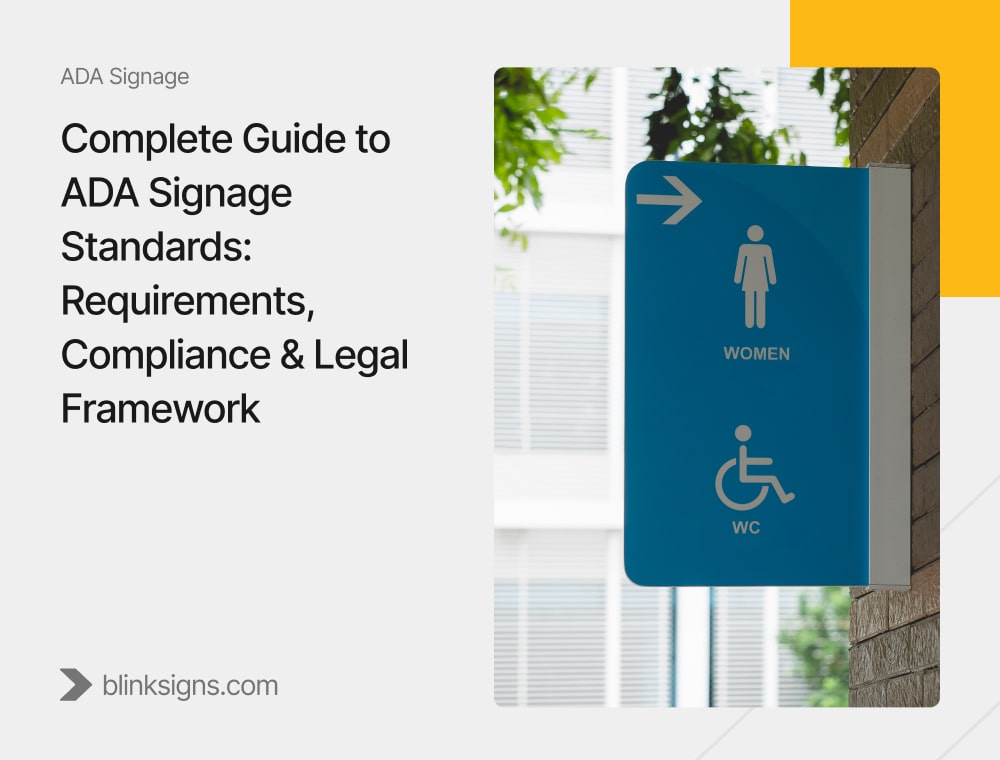
Complete Guide to ADA Signage Standards: Requirements, Compliance & Legal Framework
Why ADA Signage Compliance Defines Business Success in 2025
ADA signage compliance has evolved beyond regulatory obligation, it now represents competitive advantage, legal protection, and brand integrity. The Americans with Disabilities Act mandates that every public accommodation provide accessible signage, transforming facility navigation from a barrier into a bridge.
ADA compliant signage delivers measurable value for business owners: legal protection from costly violations, enhanced customer trust, and expanded market reach to the 61+ million Americans with disabilities. Non-compliance exposes organizations to federal penalties up to $75,000 for first violations and $150,000 for subsequent offenses, plus private lawsuits and settlement costs.
At BlinkSigns, we’ve guided thousands of facilities through ADA compliance while preserving brand aesthetics and design integrity. Our knowledge of ADA signage standards such as technical requirements, legal frameworks, and installation specifications allows us to provide signage that improves user experience while shielding companies from infractions.
Understanding ADA Signage Regulatory Framework
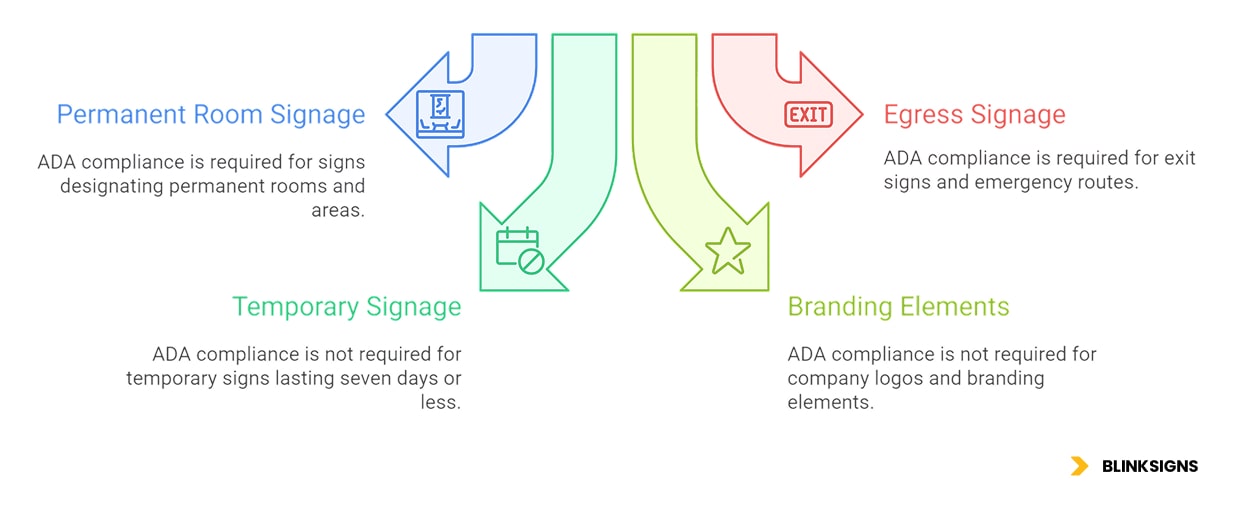
Understanding ADA Signage Regulatory Framework
Section 216: When ADA Compliance Is Required
The ADA Standards’ Section 216 establishes the parameters of signage compliance and specifies which signs need to adhere to accessibility standards. This scoping phase keeps vital signs available while avoiding over-compliance.
216.2 Designations: ADA requirements must be met by exterior and interior signage designating permanent rooms and areas. This includes bathrooms, offices, conference rooms, storage spaces, and other similar functional areas.
216.4 Means of Egress: ADA requirements must be followed by exit signs, emergency egress routes, and directional evacuation signage. These signs frequently need to be coordinated with building safety and fire codes.
What Signs Are Exempt from ADA Requirements
Understanding the ADA exemptions helps concentrate resources on necessary signage while avoiding needless compliance costs:
- Event announcements, seasonal messaging, and promotional displays are examples of temporary signage lasting seven days or less.
- Company logos and branding elements that serve identification purposes rather than navigation
- Establishing menus and informational directories in place of permanent room identification
- Parking facility signage that exceeds the specifications for accessibility symbols
Federal vs. State Enforcement Landscape
The Department of Justice (DOJ) uses investigation, litigation, and penalty assessment to enforce ADA compliance. Businesses with significant accessibility barriers or repeat offenders are usually the targets of federal enforcement.
Stricter requirements than federal minimums are frequently imposed by state and local codes, which makes compliance more difficult. To avoid gaps, skilled navigation is necessary due to Texas transportation standards, California’s stricter spacing requirements, and municipal fire codes.
Technical Specifications: Tactile Character Standards
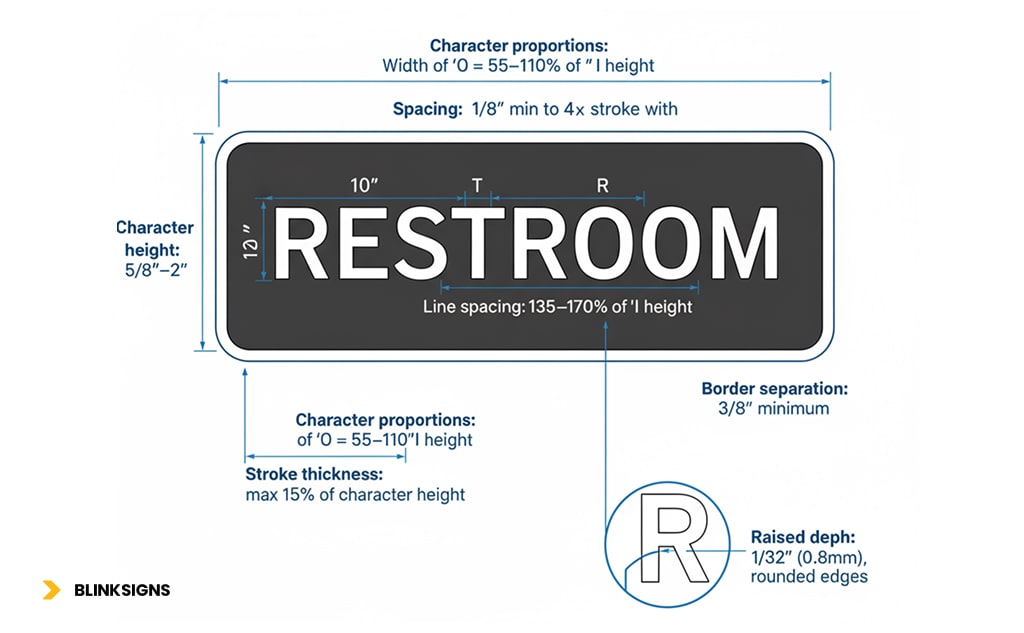
ADA Tactile Signage Measurements
Precise Character Measurements
The tactile characters provide essential access and adhere to rigorous dimensional requirements for blind and VI individuals. These raised letters must achieve a perfect balance between readability and durability.
Character Height: 5/8” to 2” maximum, measured from the uppercase “I baseline. This measurement standard ensures consistency across all tactile signage.
Stroke Thickness: 15% maximum character height based on the uppercase “I” measurement. This specification prevents characters from becoming too bold or thin for tactile reading.
Character Proportions: Width of uppercase “O” must fall between 55% and 110% of the uppercase “I” height. This proportion rule maintains font readability while preventing distorted character shapes.
Character Spacing and Separation Standards
Tactile character spacing requires a minimum of 1/8” to a maximum of 4 times stroke width measured between the closest points of adjacent characters. This spacing ensures individual character recognition during tactile reading.
Line spacing for multi-line tactile text must be 135% to 170% of the uppercase “I” height, measured baseline to baseline. Proper line spacing prevents confusion between text lines during tactile navigation.
A minimum border separation of 3/8” must separate tactile characters from raised decorative elements, frames, or logos. This separation prevents tactile interference and ensures clear character definition.
Font Requirements and Restrictions
Only uppercase, sans-serif fonts meet ADA tactile requirements. Approved fonts include Arial, Helvetica Medium, Futura Medium, and Frutiger.
Prohibited font styles include italic, oblique, script, decorative, and highly stylized typefaces that impair tactile readability. These restrictions ensure a consistent tactile experience across all compliant signage.
Raised depth must reach 1/32” (0.8mm) minimum above the background surface. Characters require rounded edges without sharp or abrasive surfaces that could injure users during tactile reading.
Braille Requirements and Grade 2 Standards
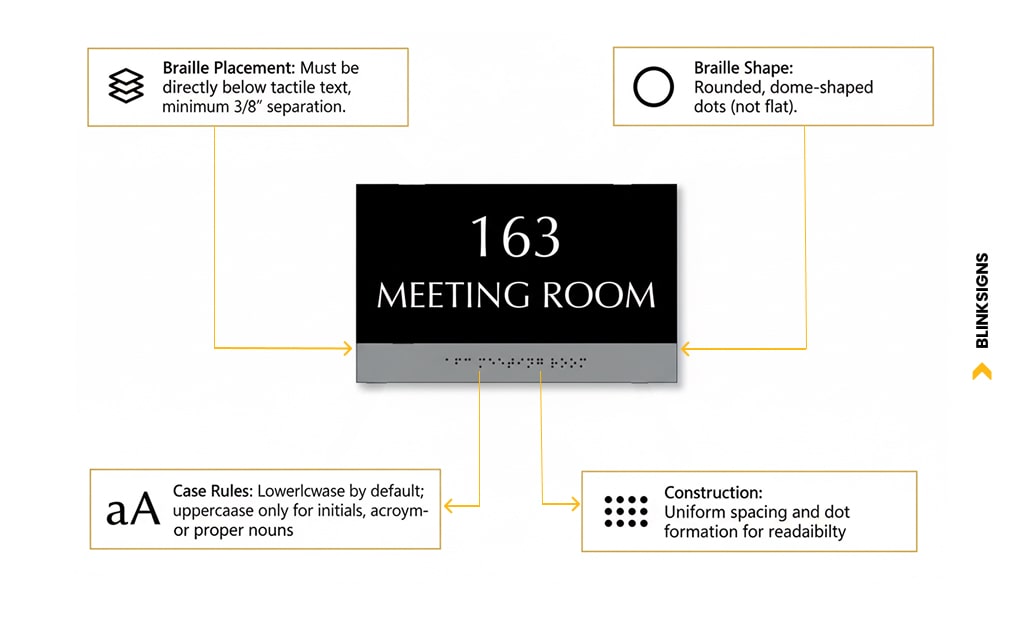
ADA Braille Signage Requirements
Mandatory Braille Applications
Grade 2 Braille appears on all permanent room identification signs, restrooms, offices, conference rooms, and similar public spaces. Temporary signs (7 days or fewer) remain exempt from Braille requirements.
Braille must be positioned directly below the corresponding tactile text with proper alignment and spacing. Multi-line text requires Braille placement below the entire text block, separated by 3/8” minimum from other tactile elements.
Braille Construction Specifications
Braille dots must feature rounded, dome-shaped surfaces rather than flat-topped configurations. This shape requirement ensures proper tactile feedback and reading comfort.
Braille case conventions follow standard rules: lowercase for most text, uppercase only before sentences, proper nouns, individual letters, initials, and acronyms. Uniform spacing and dot formation ensure consistent readability.
Visual Character Standards for Distance Reading
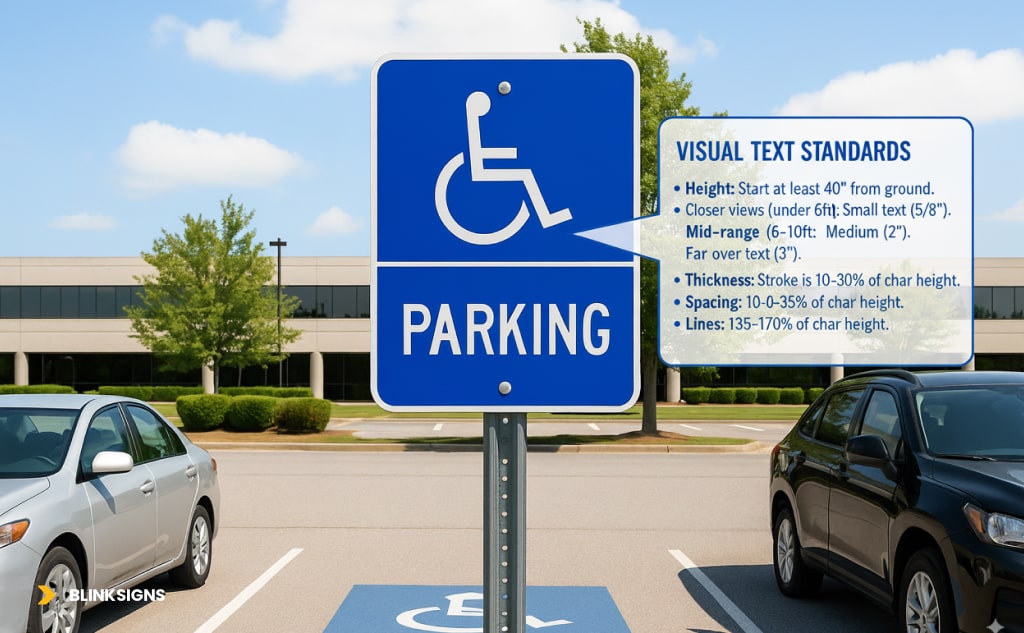
ADA Signage Visual Character Standards for Distance Reading
ADA Signage Height and Viewing Distance Calculations
Visual characters serve directional and informational signage designed for distance viewing. Unlike tactile signs, visual characters can use uppercase, lowercase, or mixed case formatting when it improves readability.
Minimum mounting height of ADA signage starts at 40” above finished floor, with character size determined by viewing distance and sign placement :
| Mounting Height | Viewing Distance | Minimum Character Height |
| 40 “-7” | Under 72” | 5/8” |
| 40 “-7” | 72” or more | 5/8” + 1/8” per foot above 72” |
| 70 “-1”0” | Under 180” | 2” |
| 70 “-1”0.” | 180” or more | 2” + 1/8” per foot above 18.0” |
| Above 120” | Under 21 feet | 3” |
| Above 120” | 21 feet or more | 3” + 1/8” per foot above 21’ |
Visual Character Proportions and Spacing
Stroke thickness for visual characters ranges from 10% to 30% of character height based on the uppercase “I”. This wider tolerance accommodates various fonts while maintaining distance legibility.
Character spacing must fall between 10% and 35% of character height, measured between the closest points of adjacent letters. Line spacing requires 135% to 170% of character height, measured baseline to baseline for multi-line signs.
Critical Exception Rule (703.5)
When visual characters comply with tactile requirements AND include Braille, they become exempt from separate visual character specifications (703.5.2 through 703.5.9). This exception allows unified sign design that meets tactile and visual needs through a single character set.
Installation and Placement: Critical Positioning Requirements
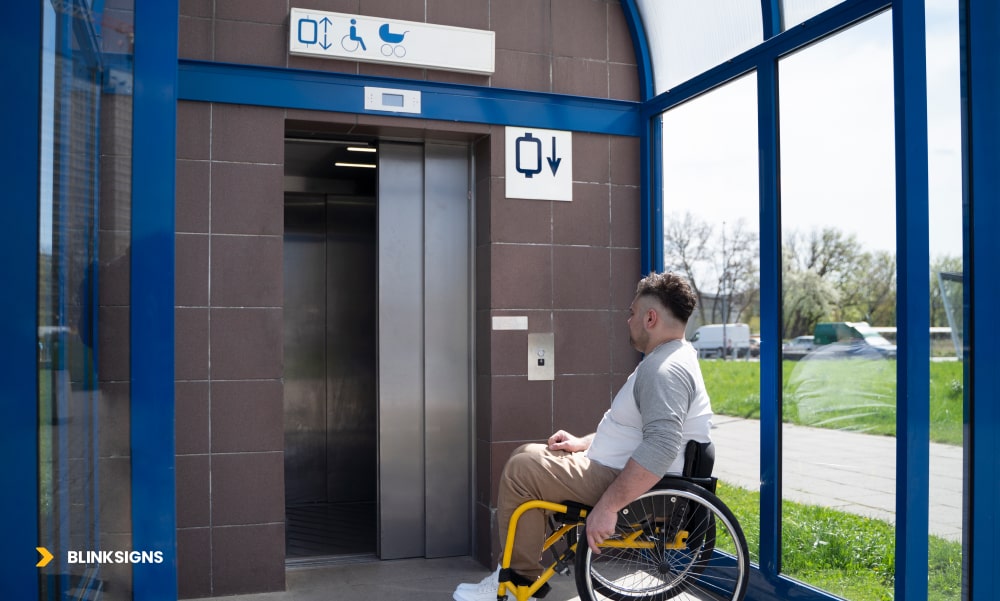
ADA compliant signage installation and placement
Clear Floor Space and Accessibility Zones
The tactile characters, which must be placed outside the arc of any swinging door from closed to 45-degree open positions, must take up to of the 18” × 18” clear floor space. Wheelchair users can approach signs without hindrance in this accessibility zone, and doors will continue to operate.
Signs must be placed at least 9 inches from the edges of door latches because the exact floor space measurement starts from the centerline of tactile characters. This distance preserves tactile access without interfering with door operation.
Precise space floor surface requirements call for solid, stable, non-slip surfaces with a maximum slope of 1:48. To guarantee uniform wheelchair approach angles, level changes are not permitted within the 18” × 18” area.
Door Configuration Placement Rules
Single-door installations require signs on the latch side at 48 “-6” height measured to the baseline of the lowest tactile character. When latch-side wall space is unavailable, signs must be placed on the nearest adjacent wall, maintaining the required clear floor space.
Double-door configurations follow specific hierarchy placement rules
- Two active leaves: Sign positioned on right-hand door (when approaching from exterior)
- One active leaf: Sign mounted on inactive door panel
- No available wall space: Nearest adjacent wall placement with proper clearances
Overhead and Projecting Sign Clearances
The minimum distance between the finished floor and the bottom edge for overhead signs is 80. Signs that span circulation paths, are suspended, or are mounted on the ceiling must comply with this regulation.
With mounting heights ranging from 27” to 80” above the finished floor, all-mounted projecting signs are limited to extending no more than 4” into circulation paths. To prevent head strike hazards, signs that are longer than 4” must have a minimum clearance of 80”.
Post-mounted signs between 27 “and -80” height cannot protrude more than 12” from posts into circulation paths. Signs mounted below 27” or above 80” can extend any distance from post structures.
Contrast, Finish, and Material Standards
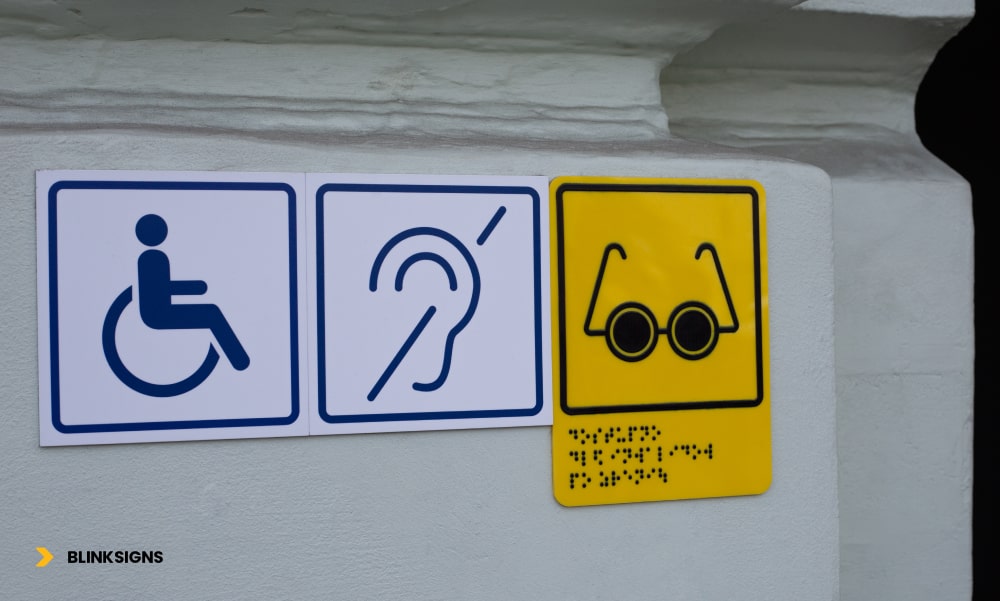
ADA-compliant signage Contrast, Finish, and Material Standards
Non-Glare Finish Requirements
All ADA compliant signs require non-glare finishes that eliminate surface reflections under varying lighting conditions. Matte, eggshell, and satin finishes meet non-glare specifications while maintaining color integrity.
Glossy, mirror-like, or highly reflective materials violate ADA standards and significantly reduce readability for low-vision or light-sensitivity users. This requirement applies to both character surfaces and background materials.
Color Contrast Standards Evolution
The 2010 ADA Standards require light-on-dark or dark-on-light combinations but removed specific percentage requirements from mandatory compliance. Industry best practice maintains a 70% minimum contrast ratio for optimal accessibility and legal protection.
Equally important is background uniformity; even when individual elements satisfy contrast requirements, patterns, textures, or color variations behind text make it difficult to read. Maximum legibility under all viewing conditions is ensured by using consistent consistent background colors.
Legal Framework and Enforcement Landscape
Federal Penalties and Risk Assessment
Penalties have increased dramatically within the Department of Justice, with first-time offenders facing penalties of $75,000 and repeat offenders facing penalties of $150,000. Civil lawsuit settlements are not included in these federal fines, although they frequently surpass regulatory penalties.
The number of class-action lawsuits aimed at non-compliance with signage is steadily increasing in the retail, hospitality, and healthcare industries. High-profile settlements that typically range from $50,000 to $500,000 show how financially risky non-compliance can be.
Proactive Compliance Strategies
ADA signage audits represent the most cost-effective risk mitigation approach, identifying violations before enforcement actions. Professional audits cost significantly less than violation penalties and provide actionable compliance roadmaps.
Documentation and certification of ADA compliance support legal defense while demonstrating reasonable faith accessibility efforts. Documentation of proper installations, material specifications, and professional certifications supports compliance positions.
Industry-Specific Applications and Challenges
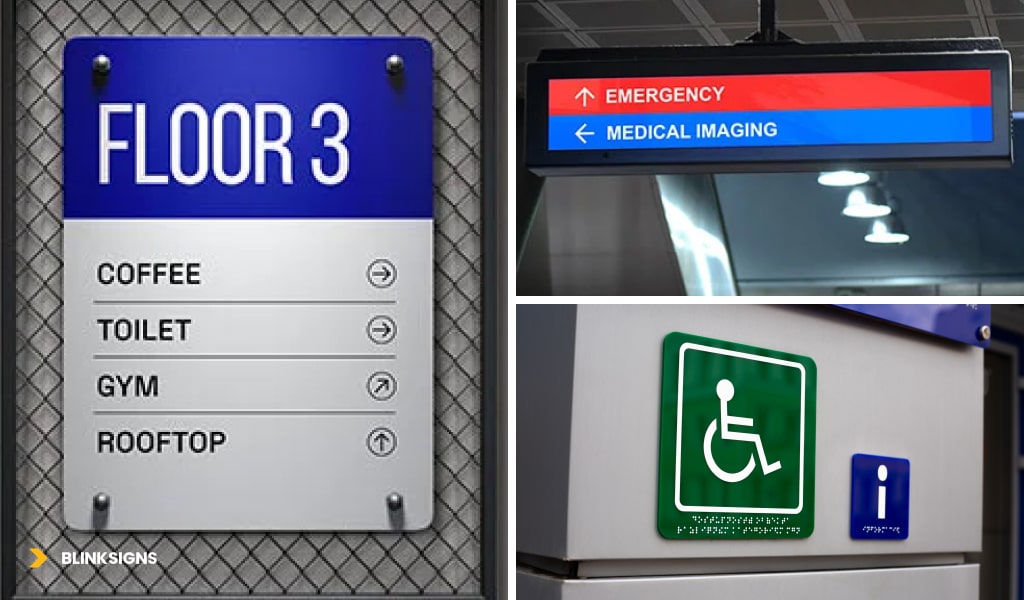
Industry-Specific Applications and Challenges of ADA signage
Healthcare Facility Requirements
Healthcare for wayfinding and patient safety, our signage must adhere to Joint Commission accreditation requirements and ADA standards. room identification, emergency egress routes, and diagnostic area signs require enhanced durability and infection control materials.
Multi-language in order to serve a variety of populations and maintain ADA compliance, healthcare settings must carefully plan for language considerations. Translations into Braille must be precise and positioned consistently in all language variations.
Educational Institution Compliance
Campus signage programs must integrate ADA requirements with security, emergency management, and fire code standards. Classroom identification, laboratory safety signs, and auditorium wayfinding require coordination across multiple regulatory frameworks.
Modular sign systems allow efficient updates for classroom changes while maintaining ADA compliance throughout facility modifications.
Retail and Hospitality Applications
Customer-facing businesses face the highest litigation risk, requiring comprehensive signage compliance programs. Restroom identification, fitting room signs, and accessible parking designations represent primary violation targets.
Brand integration with ADA requirements challenges retailers to maintain aesthetic consistency while meeting accessibility standards. Custom finishes, colors, and materials must preserve compliance while supporting brand identity.
Emerging Trends and Future Considerations
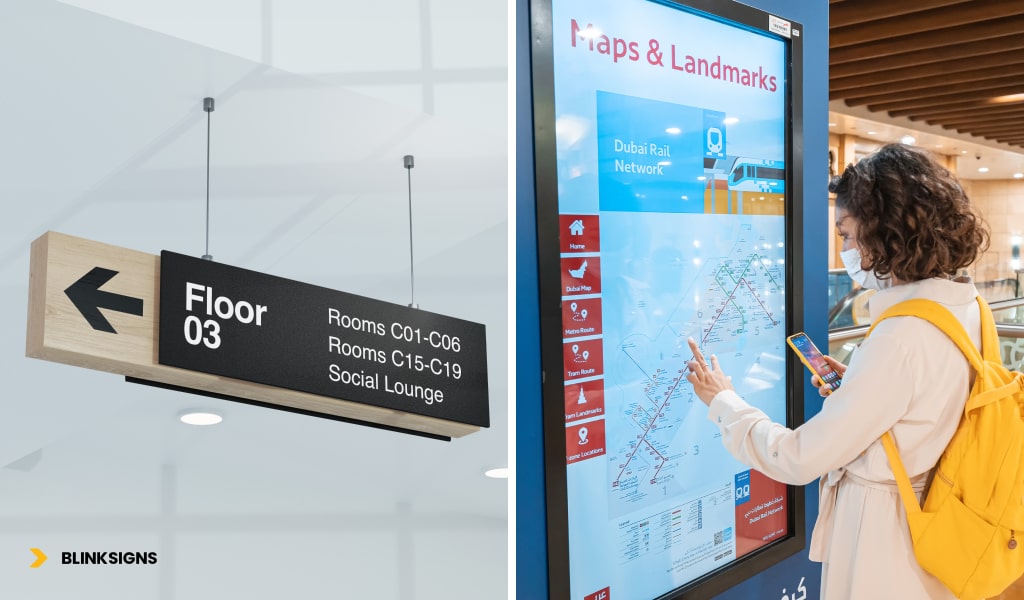
ADA signage emerging trends
Digital and Interactive Accessibility
AI-assisted wayfinding kiosks are emerging as ADA compliant digital solutions that provide voice commands, audio directions, and customizable visual displays. These systems must meet both physical ADA standards and digital accessibility requirements.
Augmented reality wayfinding offers personalized navigation assistance through smartphones, providing audio directions and visual overlays for complex facilities. Future ADA updates may expand digital accessibility requirements to include AR and mobile applications.
Sustainable ADA Signage Solutions
LEED certification programs increasingly recognize sustainable signage materials, creating demand for eco-friendly ADA compliance solutions. FSC-certified wood substrates, recycled aluminum, and low-VOC paints can contribute to multiple LEED credits.
Modular and lifecycle design reduces waste through component replacement rather than complete sign replacement during facility updates. Manufacturers now offer take-back programs for post-consumer recycling of ADA signage materials.
Domestic manufacturing reduces transportation environmental impact while supporting local economies and quality control. US-made signs typically offer more extended durability and reduced shipping-related carbon footprints.
FAQs
Q1. How is character height measured for ADA signs?
Character height is measured from the baseline of the uppercase “I”, not from ascenders, descenders, or decorative features. This measurement standard ensures consistency across all tactile and visual signage applications.
Q2. What are the exact spacing requirements for tactile characters?
Tactile characters must have spacing of 1/8” minimum to 4 times the stroke width maximum, measured between the closest points of adjacent characters. Line spacing requires 135-170% of character height measured baseline to baseline.
Q3. Are company logos and marketing signs subject to ADA requirements?
No. Company logos, marketing graphics, and advertising displays are typically exempt from ADA compliance requirements. Building addresses and temporary signage (7 days or fewer) also remain exempt.
Q4. What is the clear floor space requirement for ADA signs?
Signs with tactile characters require 18” × 18” clear floor space centered on the tactile text, positioned beyond the arc of the door swing from closed to 45-degree open positions. This space must be level, stable, and slip-resistant.
Q5. How high must overhead signs be mounted?
Overhead signs must maintain 80” minimum clearance from the finished floor to the bottom edge of the sign. Projecting wall-mounted signs extending more than 4” also require 80” clearance.
Q6. What finish is required for ADA compliant signage?
All ADA signs must have non-glare finishes such as matte, eggshell, or satin surfaces. Glossy or highly reflective finishes are prohibited as they impair readability for users with visual impairments.
Q7. Do state codes affect ADA signage requirements?
Yes. State and local building codes often impose stricter requirements than federal ADA minimums. Fire codes, transportation standards, and municipal regulations may require additional specifications beyond basic ADA compliance.
ADA Signage as Strategic Business Investment
ADA signage compliance transcends regulatory obligation—it represents strategic investment in accessibility, legal protection, and brand reputation. Businesses prioritizing comprehensive signage compliance gain competitive advantages through enhanced customer trust, expanded market reach, and protection from costly violations.
The evolving landscape of ADA requirements demands proactive compliance strategies that integrate technical precision with design excellence. Future trends toward digital accessibility, sustainable materials, and universal design principles will reward businesses that establish compliance frameworks today.
BlinkSigns delivers signage solutions that achieve full ADA compliance while preserving brand aesthetics and operational functionality. Our comprehensive approach spans design, fabrication, installation, and ongoing compliance support for businesses nationwide.
Partner with BlinkSigns for expert ADA signage compliance that protects your business, serves your customers, and strengthens your commitment to accessibility and inclusion.
Contact us today for a comprehensive compliance audit and discover how professional signage design transforms legal requirements into competitive advantages.
| Download our Free ADA Signage Compliance Checklist and stay audit-ready.